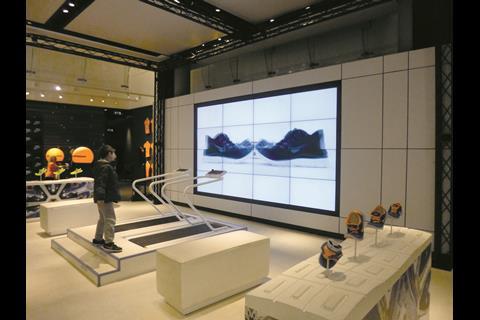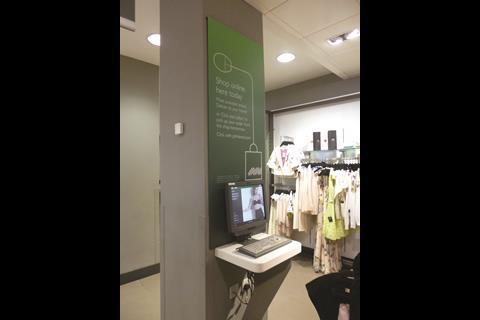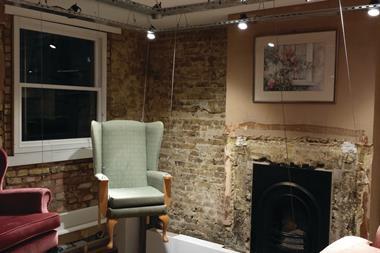In-store design increasingly includes digital elements but does that lead to higher shop revenue or are the innovations serving another purpose?
Talk to almost any retailer these days and it probably won’t be long before they say that their aim at present is to make the online and physical worlds a seamless entity.
Perhaps this is the future, given the growth curve being experienced by most retailers as far as their online activities are concerned. Yet one of the issues that confronts any retailer trying to make this a reality is how to put online and digital in store and to make it appealing.
In essence, and at its simplest, turning stores into online portals that enable shoppers to access a broader offer is no more than putting a computer into a store. That was pretty much the reality for a while as retailers installed kiosks, which turned out on not too close examination to be no more than computer terminals that were enclosed in a large, freestanding box. For the most part, things have moved on and today’s interactivity is just that - in-store technology that has been turned into part of the shopping experience, at least at retailers that are forward looking.
For the best examples of what’s possible, it does appear that branded sportswear retailers often have lessons to teach other retailers. Used effectively, the business of in-store technology is as much an element of visual merchandising and point-of-sale promotion as the physical components.
There are those, however, who still seem happy to make do with a computer in a box and to call it a day at that.
Adidas, Oxford Street
The Adidas boot wall has been a thing of beauty and fascination in selected outposts of the brand for almost two years now and yet it still has the ability to stop small boys and grown men in their tracks and to engage them at a moment’s notice.
On the day of visiting, many shoppers in the store seemed to be busy inspecting the virtual running shoes, turning them round, changing their colours and moving them up and down the large screen in a manner not unlike an oversized fruit machine.
In terms of in-store technology, when it was released this was about as interactive and engaging as it got on the high street. There is a question mark over whether it actually generates any additional turnover because there is no real call to action. It does create a focal point for visiting shoppers however.
There is a sense that the best in-store technology has the capacity to stay the course over the longer term.
Nike, Oxford Circus
To an extent, the better-end of sports equipment and clothing retailing is at the forefront of in-store developments in technology because the products are largely about making people feel better about themselves.
To this end, there are screens everywhere one looks in the world’s biggest Nike store, where on the ground floor (incredibly expensive in this part of town) there is an almost cavalier disregard for the cost of space. The retailer devotes large areas to combinations of screens and running equipment.
On the left-hand side is a large floor-to-ceiling screen that has a pair of running machines in front of it. Customers can jog and interact with the screen, while the Nike+ FuelBand, a device that measures running distance among other things, is available to use with a large screen on the other side of the floor. Smaller screens set into the tops of freestanding plinths also commend the high-tech virtues of the Nike+ FuelBand. Upstairs, the banks of computers that allow consumers to design their own running shoes continue to attract large numbers of shoppers.
The store is about using technology to sell and to create a true experience. The other point is that what is on display is changed on a fairly regular basis. That is expensive to do but does provide shoppers with reason to return.
John Lewis, Oxford Street
A lot has been written about the e-wave that John Lewis is riding at present, and its in-store/virtual link has been established for a while now, but it keeps a low, albeit visible, profile across the Oxford Street store. Throughout the shop there are keyboards linked to screens and attached to pillars that allow customers to click and shop.
Railcards on top of pieces of equipment inform shoppers about the service and the news from the small-format store in Exeter is that this is a telling way of fitting a quart into a pint pot as far as sales are concerned. Maybe so, yet, on repeated visits to the Oxford Street leviathan, it is highly unusual to see customers heading for the keyboards - most are intent on shopping the in-store offer and leave the helpful staff to do the necessary if what they want is not on display.
That said, the manner in which digital has been made an unobtrusive part of the in-store landscape without any kind of song and dance is indicative of a retailer that is at ease with being a multichannel operator.
Hamleys, Regent Street
As the spiritual home of the product demonstrator, Hamleys is certainly the kind of place where shoppers might think that the tech element of stores would be straightforward - absent. In fact, the retailer shows what is possible at the front of the store. A boomerang demonstrator does the throwing and returning thing, while behind him a mid-shop piece of point-of-sale features two screens, both intended to back up what is being demonstrated.
This is human-assisted technology and, while the crowds were busy watching boomerangs whizzing round the shop, they were also looking at what was happening on the screens. The interactivity in this instance was provided by the demonstrator with the technology as a back-up. It’s a strategy that could be adopted by other retailers as shoppers often remain resistant to the blandishments of unassisted in-store technology.
Dr Martens, Carnaby Street
The Dr Martens store on Carnaby Street opened at the tail end of 2012 and is the brand’s London flagship. Spread across two floors, at the top of the staircase to the first floor there is a kiosk that encourages shoppers to flex their social media muscles.
The deal is simple. Have a photo taken - customers have three chances - and then post the result on the Dr Martens Facebook page in exchange for the chance to win a pair of the fashionable bovver boots. This is a fairly low-tech system but there is a real chance that it will be used, if only because there is a tangible potential reward. This is not about selling items - it is solely concerned with customer engagement.
Demands for digital design
David Dalziel, creative director at design consultancy Dalziel + Pow, says that digital is one of the major demands made by retailers when they set about creating a new store blueprint.
He says: “We’re expecting that digital will be around a third of our business within a couple of years. There isn’t a single brief that arrives these days without some element of digital. Digital is clearly going one way and we have to get beyond the slave screens pumping out images that characterise so many retailers at the moment.
“A lot of things that we’re doing in digital are about surprise and entertainment, rather than transaction. It’s about ideas instead of fulfilment.”
This may explain why some retailers remain less than convinced about the merits of in-store digital. The notion that digital may be about experience rather than revenue is an unexplored avenue for some.




































No comments yet